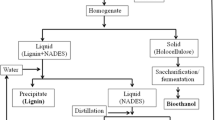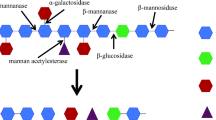Abstract
Most studies of the mode of action of industrially important endoxylanases have been done on alkali extracted-plant xylan. In just few cases, the native form of the polysaccharide, acetylated xylan, was used as a substrate. In this work action of xylanases belonging to three glycoside hydrolase families, GH10, GH11, and GH30 was investigated on acetylglucuronoxylan directly in hardwood cell walls. Powdered eucalyptus wood was used as xylanase substrate. Enzyme-generated fragments were characterized by TLC, MALDI ToF MS, and NMR spectroscopy. All three xylanases generated from eucalyptus wood powder acetylated xylooligosaccharides. Those released by GH10 enzyme were the shortest, and those released by GH30 xylanase were of the largest diversity. For GH30 xylanase the 4-O-methyl-D-glucuronic acid (MeGlcA) side residues function as substrate specificity determinants regardless the acetylation of the neighboring hydroxyl group. Much simpler xylooligosaccharide patterns were observed when xylanases were applied in combination with carbohydrate esterase family 6 acetylxylan esterase. In the presence of the esterase, all aldouronic acids remained 3-O-acetylated on the xylopyranosyl (Xylp) residue substituted with MeGlcA. The 3-O-acetyl group, in contrast to the acetyl groups of otherwise unsubstituted Xylp residues, does not affect the mode of action of endoxylanases, but contributes to recalcitrance of the acidic xylan fragments. The results confirm importance of acetylxylan esterases in microbial degradation of acetylated hardwood glucuronoxylan. They also point to still unresolved question of efficient enzymatic removal of the 3-O-acetyl group on MeGlcA-substituted Xylp residues negatively affecting the saccharification yields.






Similar content being viewed by others
Abbreviations
- Xylp :
-
β-D-xylopyranosyl residue
- MeGlcA:
-
4-O-methyl-D-glucuronic acid
- GH:
-
Glycoside hydrolase
- CE:
-
Carbohydrate esterase
- Xyln :
-
β-1,4-xylooligosaccharide of n Xylp residues
- MeGlcAiXyln :
-
Aldouronic acid containing one residue of MeGlcA linked to Xylp residue marked in Xyln with i which is the number of Xylp residue counted from the reducing end (i would be equal to 1 if MeGlcA would be linked to the reducing-end Xyl, 2 if MeGlcA would be linked to the second Xylp residue from the reducing end, etc.
- Ac3MeGlcA3Xyl3 :
-
Aldotetraouronic acid in which both MeGlcA and the acetyl group are linked to non-reducing-end Xylp residue of Xyl3
- Ac3MeGlcA3Xyl4 :
-
Aldopentaouronic acid in which both MeGlcA and the acetyl group are linked to penultimate Xylp residue from the non-reducing-end of Xyl4
- MeGlcA3Xyl3Ac2 2,3 :
-
Aldotetraouronic acid MeGlcA3Xyl3 doubly acetylated at the middle and non-reducing-end Xylp residues
References
Aachary AA, Prapulla SG (2011) Xylooligosaccharides (XOS) as an emerging prebiotic: microbial synthesis, utilization, structural characterization, bioactive properties, and applications. Comprehen Rev Food Sci Food Safety 10(1):2–16. https://doi.org/10.1111/j.1541-4337.2010.00135.x
Appeldoorn MM, de Waard P, Kabel MA, Gruppen H, Schols HA (2013) Enzyme resistant feruloylated xylooligomer analogues from thermochemically treated corn fiber contain large side chains, ethyl glycosides and novel sites of acetylation. Carbohydr Res 381:33–42. https://doi.org/10.1016/j.carres.2013.08.024
Biely P, Vršanská M, Tenkanen M, Kluepfel D (1997) Endo-β-1,4-xylanase families: differences in catalytic properties. J Biotechnol 57(1-3):151–166. https://doi.org/10.1016/S0168-1656(97)00096-5
Biely P, Hirsch J, la Grange DC, van Zyl WH, Prior BA (2000) A chromogenic substrate for a β-xylosidase-coupled assay of α-glucuronidase. Anal Biochem 286(2):289–294. https://doi.org/10.1006/abio.2000.4810
Biely P, Cziszárová M, Uhliariková I, Agger JW, Li X-L, Eijsink VGH, Westereng B (2013) Mode of action of acetylxylan esterases on acetyl glucuronoxylan and acetylated oligosaccharides generated by a GH10 endoxylanase. Biochim Biophys Acta 1830(11):5075–5086. https://doi.org/10.1016/j.bbagen.2013.07.018
Biely P, Cziszárová M, Agger JW, Li X-L, Puchart V, Vršanská M, Eijsink VGH, Westereng B (2014a) Trichoderma reesei CE16 acetyl esterase and its role in enzymatic degradation of acetylated hemicellulose. Biochim Biophys Acta 1840(1):516–525. https://doi.org/10.1016/j.bbagen.2013.10.008
Biely P, Westereng B, Puchart V, de Maayer P, Cowan DA (2014b) Recent progress in understanding the mode of action of acetylxylan esterases. J Appl Glycosci 61(2):35–44. https://doi.org/10.5458/jag.jag.%20JAG-2013_018
DuBois M, Gilles KA, Hamilton JK, Rebers PA, Smith F (1956) Colorimetric method for determination of sugars and related substances. Anal Chem 28(3):350–356. https://doi.org/10.1021/ac60111a017
Evtuguin DV, Tomás JL, Silva AMS, Neto CP (2003) Characterization of an acetylated heteroxylan from Eucalyptus globulus Labill. Carbohydr Res 338(7):597–604. https://doi.org/10.1016/S0008-6215(02)00529-3
Fujimoto Z, Kaneko S, Kuno A, Kobayashi H, Kusakabe I, Mizuno H (2004) Crystal structures of decorated xylooligosaccharides bound to a family 10 xylanase from Streptomyces olivaceoviridis E-86. J Biol Chem 279(10):9606–9614. https://doi.org/10.1074/jbc.M312293200
Gallardo Ó, Fernández-Fernández M, Valls C, Valenzuela SV, Roncero MB, Vidal T, Díaz P, Pastor FIJ (2010) Characterization of a family GH5 xylanase with activity on neutral oligosaccharides and evaluation as a pulp bleaching aid. Appl Environ Microbiol 76(18):6290–6294. https://doi.org/10.1128/AEM.00871-10
Gullón P, González-Muñoz MJ, van Gool MP, Schols HA, Hirsch J, Ebringerová A, Parajó JC (2011) Structural features and properties of soluble products derived from Eucalyptus globulus hemicelluloses. Food Chem 127(4):1798–1807. https://doi.org/10.1016/j.foodchem.2011.02.066
Huang YC, Chen G-H, Chen Y-F, Chen W-L, Yang C-H (2010) Heterologous expression of thermostable acetylxylan esterase gene from Thermobifida fusca and its synergistic action with xylanase for the production of xylooligosaccharides. Biochem Biophys Res Commun 400(4):718–723. https://doi.org/10.1016/j.bbrc.2010.08.136
Juturu V, Wu JC (2012) Microbial xylanases: engineering, production and industrial applications. Biotechnol Adv 30(6):1219–1227. https://doi.org/10.1016/j.biotechadv.2011.11.006
Katapodis P, Vršanská M, Kekos D, Nerinckx W, Biely P, Claeyssens M, Macris BJ, Christakopoulos P (2003) Biochemical and catalytic properties of an endoxylanase purified from the culture filtrate of Sporotrichum thermophile. Carbohydr Res 338(18):1881–1890. https://doi.org/10.1016/S0008-6215(03)00291-X
Kormelink FJM, Gruppen H, Viëtor RJ, Voragen AGJ (1993a) Mode of action of the xylan-degrading enzymes from Aspergillus awamori on alkali-extractable cereal arabinoxylans. Carbohydr Res 249(2):355–367. https://doi.org/10.1016/0008-6215(93)84100-K
Kormelink FJM, Hoffmann RA, Gruppen H, Voragen AGJ, Kamerling JP, Vliegenthart JFG (1993b) Characterisation by 1H NMR spectroscopy of oligosaccharides derived from alkali-extractable wheat-flour arabinoxylan by digestion with endo-(1 → 4)-β-D- xylanase III from Aspergillus awamori. Carbohydr Res 249(2):369–382. https://doi.org/10.1016/0008-6215(93)84101-B
Masarin F, Norambuena M, Ramires HOR, Demuner BJ, Pavan PC, Ferraz A (2016) Manganese peroxidase and biomimetic systems applied to in vitro lignin degradation in Eucalyptus grandis milled wood and kraft pulps. J Chem Technol Biotechnol 91(5):1422–1430. https://doi.org/10.1002/jctb.4739
Neumüller KG, Carvalho de Souza A, JHJ R, Streekstra H, Gruppen H, Schols HA (2015) Positional preferences of acetyl esterases from different CE families towards acetylated 4-O-methyl glucuronic acid-substituted xylo-oligosaccharides. Biotechnol Biofuels 8(1):art. 7. https://doi.org/10.1186/s13068-014-0187-6
Nishitani K, Nevins DJ (1991) Glucuronoxylan xylanohydrolase. A unique xylanase with the requirement for appendant glucuronosyl units. J Biol Chem 266(10):6539–6543
Paleg LG (1959) Citric acid interference in the estimation of reducing sugars with alkaline copper reagents. Anal Chem 31(11):1902–1904. https://doi.org/10.1021/ac60155a072
Pell G, Taylor EJ, Gloster TM, Turkenburg JP, Fontes CMGA, Ferreira LMA, Nagy T, Clark SJ, Davies GJ, Gilbert HJ (2004) The mechanisms by which family 10 glycoside hydrolases bind decorated substrates. J Biol Chem 279(10):9597–9605. https://doi.org/10.1074/jbc.M312278200
Puchart V, Biely P (2015) Redistribution of acetyl groups on the non-reducing end xylopyranosyl residues and their removal by xylan deacetylases. Appl Microbiol Biotechnol 99(9):3865–3873. https://doi.org/10.1007/s00253-014-6160
Puchart V, Agger JW, Berrin J-G, Várnai A, Westereng B, Biely P (2016) Comparison of fungal carbohydrate esterases of family CE16 on artificial and natural substrates. J Biotechnol 233:228–236. https://doi.org/10.1016/j.jbiotec.2016.07.003
Shatalov AA, Evtuguin DV, Neto CP (1999) (2-O-α-D-Galactopyranosyl-4-O-methyl-α-D-glucurono)-D-xylan from Eucalyptus globulus Labill. Carbohydr Res 320(1-2):93–99. https://doi.org/10.1016/S0008-6215(99)00136-6
St John FJ, Rice JD, Preston JF (2006) Characterization of XynC from Bacillus subtilis subsp. subtilis strain 168 and analysis of its role in depolymerization of glucuronoxylan. J Bacteriol 188(24):8617–8626. https://doi.org/10.1128/JB.01283-06
Teleman A, Lundqvist J, Tjerneld F, Stålbrand H, Dahlman O (2000) Characterization of acetylated 4-O-methylglucuronoxylan isolated from aspen employing 1H and 13C NMR spectroscopy. Carbohydr Res 329(4):807–815. https://doi.org/10.1016/S0008-6215(00)00249-4
Teleman A, Tenkanen M, Jacobs A, Dahlman O (2002) Characterization of O-acetyl-(4-O-methylglucurono)xylan isolated from birch and beech. Carbohydr Res 337(4):373–377. https://doi.org/10.1016/S0008-6215(01)00327-5
Urbániková Ľ, Vršanská M, Mørkeberg Krogh KBR, Hoff T, Biely P (2011) Structural basis for substrate recognition by Erwinia chrysanthemi GH30 glucuronoxylanase. FEBS J 278(12):2105–2116. https://doi.org/10.1111/j.1742-4658.2011.08127.x
Vázquez MA, Alonso JL, Dominguez H, Parajó JC (2000) Xylooligosaccharides: manufacture and applications. Trends Food Sci Technol 11(11):387–393. https://doi.org/10.1016/S0924-2244(01)00031-0
Vršanská M, Kolenová K, Puchart V, Biely P (2007) Mode of action of glycoside hydrolase family 5 glucuronoxylan xylanohydrolase from Erwinia chrysanthemi. FEBS J 274(7):1666–1677. https://doi.org/10.1111/j.1742-4658.2007.05710.x
Wan Q, Zhang Q, Hamilton-Brehm S, Weiss K, Mustyakimov M, Coates L, Langan P, Graham D, Kovalevsky A (2014) X-ray crystallographic studies of family 11 xylanase Michaelis and product complexes: implications for the catalytic mechanism. Acta Crystallogr D70(1):11–23. https://doi.org/10.1107/S1399004713023626
Westereng B, Coenen GJ, Michaelsen EE, Voragen AGJ, Samuelsen AB, Schols HA, Knutsen SH (2009) Release and characterization of single side chains of white cabbage pectin and their complement-fixing activity. Mol Nutr Food Res 53(6):780–789. https://doi.org/10.1002/mnfr.200800199
Widner B, Thomas M, Sternberg D, Lammon D, Behr R, Sloma A (2000) Development of marker-free strains of Bacillus subtilis capable of secreting high levels of industrial enzymes. J Ind Microbiol Biotechnol 25(4):204–212. https://doi.org/10.1038/sj.jim.7000051
Zheng F, Huang J, Yin Y, Ding S (2013) A novel neutral xylanase with high SDS resistance from Volvariella volvacea: characterization and its synergistic hydrolysis of wheat bran with acetyl xylan esterase. J Ind Microbiol Biotechnol 40(10):1083–1093. https://doi.org/10.1007/s10295-013-1312-4
Acknowledgements
The authors are thankful to Dr. Andre L. Ferraz (University of Sao Paulo, Lorena, Brazil) for supplying eucalyptus wood powder. Dr. Iveta Uhliariková (Institute of Chemistry, Slovak Academy of Sciences) is gratefully acknowledged for NMR spectroscopy measurements. This work was supported by the Slovak Research and Development Agency under the contract No. APVV-0602-12, and by Scientific Grant Agency under the contract No. 2/0016/18. This work was also supported by the Research & Development Operation Programme funded by the European Regional Development Fund (ITMS 26220120054) and by SP Grant 2003SP200280203.
Funding
This study was funded by Slovak Research and Development Agency (grant number APVV-0602-12) and Scientific Grant Agency (grant number 2/0016/18).
Author information
Authors and Affiliations
Corresponding author
Ethics declarations
Conflict of interest
The authors declare that they have no conflict of interest.
Ethical approval
This article does not contain any studies with human participants or animals performed by any of the authors.
Rights and permissions
About this article
Cite this article
Puchart, V., Fraňová, L., Mørkeberg Krogh, K.B.R. et al. Action of different types of endoxylanases on eucalyptus xylan in situ. Appl Microbiol Biotechnol 102, 1725–1736 (2018). https://doi.org/10.1007/s00253-017-8722-6
Received:
Revised:
Accepted:
Published:
Issue Date:
DOI: https://doi.org/10.1007/s00253-017-8722-6




